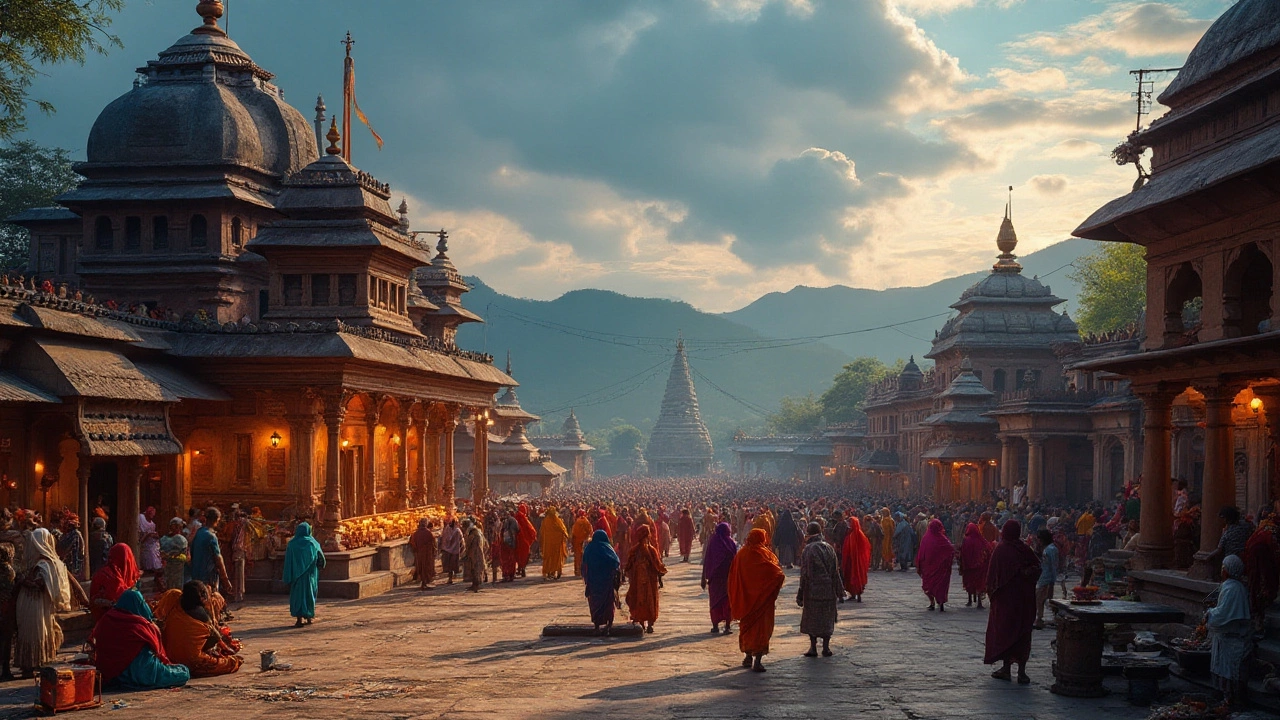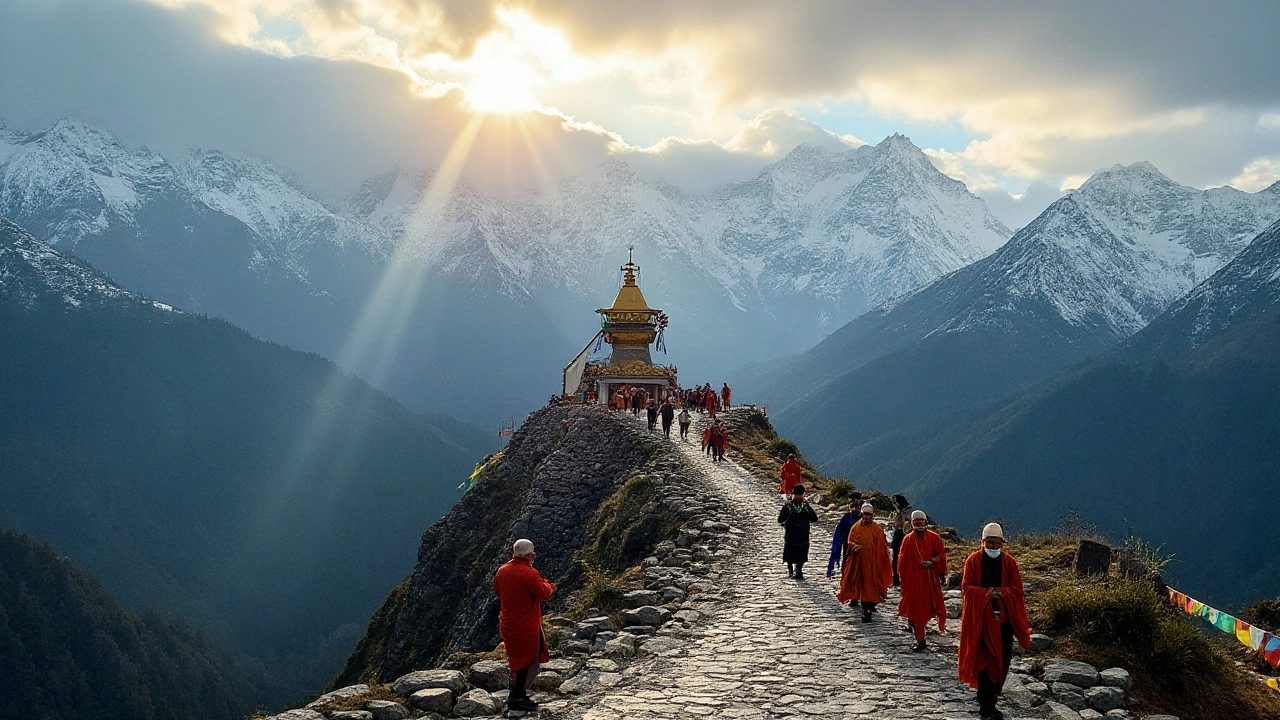Across the vast and diverse landscape of India, 12 sacred shrines known as Jyotirlingas invite pilgrims from around the world. These revered temples are dedicated to Lord Shiva, one of the principal deities in Hinduism, and represent his infinite light. Each jyotirlinga is distinct, with its own history, legends, and spiritual essence.
The journey of exploring these holy sites is not just a physical pilgrimage but a deep spiritual experience that connects one to the rich tapestry of India's religious heritage. From the snow-clad peaks of Kedarnath in the north to the coastal beauty of Rameshwar in the south, these temples are scattered across states, each with unique architectural styles and surroundings that reflect the cultural diversity of India.
- Understanding the Concept of Jyotirlingas
- Unique Features of Each Jyotirlinga Temple
- Legends and Myths Surrounding the Jyotirlingas
- Travel Tips for Pilgrims
- Cultural Significance and Rituals
Understanding the Concept of Jyotirlingas
The term Jyotirlinga finds its roots in the Sanskrit words 'Jyoti' meaning radiance and 'Linga' which refers to the sacred symbol of Lord Shiva. A Jyotirlinga is thus a divine representation of the god's infinite light and is a central symbol in Shaivism, one of the major traditions within Hinduism. As legend has it, these 12 Jyotirlingas were established at the exact spots where Shiva is said to have appeared in the form of a fiery column of light. Thus, each of these shrines stands as a beacon of purity, spiritual wisdom, and immense power, holding a unique place in the hearts of devotees.
Exploring the concept of Jyotirlingas involves delving into both mythological tales and historical accounts. Each Jyotirlinga is said to embody a distinct tale, often centered around the interplay of divine forces and human endeavors. For instance, the Somnath Jyotirlinga, located in Gujarat, is one of the oldest pilgrimage sites known for its rich history, which tells a story of resilience and rebirth through repeated destruction and reconstruction over centuries. This temple stands as a testament to the timelessness of spiritual devotion and the enduring faith of millions of worshipers.
The significance of visiting the Jyotirlingas is manifold. Many believe that a pilgrimage to these temples can cleanse one's soul of past sins and grant liberation from the cycle of birth and death. Spiritual seekers frequently embark on this journey, which is not just about visiting stone structures but about experiencing a profound connection with the divine. During a 2007 conference on Indian spirituality, scholar Dr. Anita Sharma emphasized,
"The Jyotirlingas are not merely religious monuments, but they are spiritual epiphanies that aid in the pilgrimage of the soul."Such sentiments capture the deep reverence that surrounds these sacred sites.
The Jyotirlingas are dispersed across the length and breadth of India, each adding to the cultural mosaic of the country. From the icy surroundings of the Kedarnath temple high in the Himalayas to the coastal landscape embracing the Rameshwar temple in Tamil Nadu, these holy spots are housed amid picturesque settings, drawing pilgrims and travelers alike not only for worship but also for the profound peace and natural beauty they offer. Many of these temples have stood for over a thousand years, drawing historians and architects interested in the ancient Indian architectural marvels they exhibit.
Each Jyotirlinga site follows unique rituals and traditions that connect them intimately with the local populations. These customs offer a glimpse into the diverse religious practices and societal structures of the areas they inhabit. For instance, the annual Maha Shivaratri festival at the Varanasi's Kashi Vishwanath sees thousands gathering to observe rites that have been passed down for generations, adding to the cultural richness of these spiritual centers. As a traveler or pilgrim, understanding these elements enriches the experience and provides a deeper knowledge of the dynamic Indian heritage.
Unique Features of Each Jyotirlinga Temple
Each Jyotirlinga temple in India is a testament to the country's rich cultural and religious tapestry, with every temple narrating its own story of devotion and divine presence. Consider the majestic temple of Somnath in Gujarat, which holds the distinction of being the first among the 12 Jyotirlingas. This temple, reconstructed several times due to repeated destruction throughout history, reflects resilience and unwavering faith, making it a remarkable site both spiritually and historically. Legend states that the moon god, Chandra, built the Somnath Temple out of gold, boasting its immense wealth and divinity.
Moving eastward, one finds the Mallikarjuna Temple nestled on the scenic hills of Srisailam in Andhra Pradesh. This Jyotirlinga, believed to be the abode where Shiva and Parvati reside together, is not only significant for its spiritual aura but also for its stunning architecture surrounded by nature. Here, the pilgrimage involves both a spiritual and natural journey as the temple is located amidst dense forests, providing pilgrims with serene environment.
Noteworthy is the Mahakaleshwar Temple in Ujjain, Madhya Pradesh. Unlike other temples, the face of Mahakal (Shiva) is dakshinamukhi, or facing south. This unique orientation is deeply rooted in beliefs of protecting devotees against misfortunes. The temple is famous for the Bhasma Aarti, a ritual involving sacred ash believed to have powerful cleansing energy.
The Hindu sage Adi Shankaracharya extolled the Mahakaleshwar jyotirlinga as a potent site of miracles and protection, highlighting its place amongst the Jyotirlingas.
Heading north, the Kedarnath Temple perched at a height of 3,583 meters in the Himalayas, is one of the most revered and remote Jyotirlingas. The challenging trek to reach the temple is itself a journey of faith. Known for its stone architecture against the backdrop of snow-capped peaks, Kedarnath is a visual and spiritual spectacle. It's notable for being open only six months a year due to extreme weather, further emphasizing its mystical allure.
Down in Tamil Nadu, the Rameshwar Temple is associated with Lord Rama's journey from the epic Ramayana. This temple is a vital part of the Char Dham yatra and is a bustling site of pilgrimage. The temple boasts one of the longest corridors among Indian temples, and devotees find tranquility by taking a ritual bath in the holy water, believed to cleanse sins and purify the soul. This temple marries religious significance with architectural grandeur, offering a profound insight into historical temple art and construction.
As we navigate through these sacred sites, we uncover the complex layers that form the spiritual and cultural identity of India. Each temple has not only geographical but emotional uniqueness, providing a diverse tapestry of temples that have been celebrated over centuries for their unique expressions of faith and devotion.

Legends and Myths Surrounding the Jyotirlingas
The enchanting tales of the Jyotirlinga temples carry travelers into the realm of divine legends, where mystical stories are woven through the fabric of India's ancient spirituality. Each of these sacred sites is enshrined in myths that speak of supernatural occurrences and divine events, altering the course of human faith and history. Let's embark on a journey through these captivating legends, each narrating the ways in which Lord Shiva manifested his divine light and left an eternal spiritual imprint.
Take, for example, the tale of Somnath, the first among the twelve Jyotirlinga. It is said that the moon god, Chandra, was relieved of a curse by bathing in the holy waters of Somnath. This miraculous healing rendered the site a beacon of hope and renewal for devotees. Another enthralling story unfolds at the Mallikarjuna temple, nestled in the serene hills of Andhra Pradesh, where Shiva and Parvati desired to reside close to the earthly dwelling of their son, Kartikeya, thus establishing a divine family bond atop the tranquil hill.
The mythical narrative of Mahakaleshwar in Ujjain reveals Mahadev's fierce manifestation as a destroyer of demons, by protecting the kingdom of Avanti from imminent destruction. This event fortified the divine stature of the temple, drawing pilgrims seeking divine intervention against evil. In contrast, the soft and tender legend of the Omkareshwar Jyotirlinga tells of Shiva taking form to grant the religious penance of the king Mandhata, highlighting his benevolent nature.
"These tales are not mere stories; they are the living expressions of faith and devotion that have shaped the very spirit of our culture," said Dr. Ranjana Biswas, a noted scholar on Indian mythology.Perhaps most intriguing is the myth associated with Kedarnath. Deep in the majestic Himalayas, this shrine marks the spot where Shiva took the form of a bull to elude the pursuit of the Pandavas, part of the epic Mahabharata. This narrative, filled with drama and symbolism, imparts the teachings of detachment and ultimate liberation.
The Jyotirlingas are thus more than sacred structures; they are sanctified testimonies of spiritual resilience and divine interplay. Each narrative invites pilgrims to reflect, offering insights into the diverse manifestations of the divine across the spiritual expanse of India. From beaches to mountains, these temples embody the limitless power and benevolence of Lord Shiva, influencing not just devotees but also the countless visitors drawn by the compelling mysticism of these myths.
Travel Tips for Pilgrims
Embarking on a journey to visit the 12 Jyotirlinga temples is a profound experience. It's crucial to plan the pilgrimage well to make the most of both the spiritual and the physical journey. One of the first considerations should be the timing. India experiences a vast range of climatic conditions, so choosing the right season is fundamental. For instance, visiting Kedarnath in the Himalayan region is advisable during the summer months of May to June before the monsoon begins. Meanwhile, temples in the southern region such as Rameshwar are best visited during the cooler months from December to February.
Traveling across India to reach each of the Jyotirlinga sites involves covering various terrains and distances. Many pilgrims find it helpful to create an itinerary that groups temples located in proximity. For instance, Maharashtra is home to three significant jyotirlingas—Trimbakeshwar, Bhimashankar, and Grishneshwar—which can be visited in a single trip. Utilizing long-distance trains offers a vibrant glimpse into the country’s diversity while being a budget-friendly mode of transportation for engaging in spiritual tourism.
The cultural diversity of India means food habits and languages differ immensely between regions. It's essential to be adaptable and open to trying new things. That said, in most places near these temples, you will find simple vegetarian meals which support your journey’s spiritual aspect. Many pilgrimage sites have accommodation facilities within temple complexes or nearby, which provide a serene environment for meditation and reflection.
Health and safety are crucial considerations when embarking on such long journeys. Carry a first-aid kit with essential medicines as some sites like Kedarnath involve trekking and higher altitudes which could affect those unaccustomed to it. Also, keeping hydrated and safe from sun exposure when visiting temples like Somnath in Gujarat's coastal climate is important.
Engaging with the local culture can enrich your pilgrimage. Interactions with temple priests and local devotees can offer insights into regionals myths and rituals unique to each Jyotirlinga. "Each temple has its essence, capturing a piece of India's soul," as described by the Indian spiritual sage Jaggi Vasudev in one of his teachings.
Understanding the local customs and participating respectfully in temple rituals can deepen your spiritual journey while also ensuring you are mindful of the traditions and beliefs of the communities you visit.

Cultural Significance and Rituals
The 12 Jyotirlinga temples hold profound cultural significance, serving as beacons of spiritual light across India's sacred geography. Each temple represents a unique aspect of Lord Shiva's infinite form, making them pivotal centers of worship and celebration for millions of devotees. Historically, they emerged as distinct focal points of Shiva worship, shaping local culture and traditions. During important festivals such as Maha Shivaratri, throngs of devotees converge at these temples, participating in elaborate rituals that include anointing the Shiva Lingam with milk, curd, honey, and other auspicious substances. The atmosphere is charged with devotion, as chants of 'Om Namah Shivaya' reverberate, filling the air with spiritual fervor. These practices are said to purify the mind and bring peace to the hearts of worshippers, reinforcing the timeless principles of faith, humility, and renunciation associated with Shiva.
Apart from religious rituals, each Jyotirlinga site hosts vibrant cultural activities that reflect the region's heritage and communal spirit. Temples like Somnath and Varanasi become a hub of dance and music during these festivities, with performances that narrate sacred tales from Hindu mythology. These cultural displays not only entertain but also educate devotees about the rich tapestry of Shiva's tales. As pilgrims journey across these 12 sites, they embark on an immersive exploration of local customs, language, and artistry, providing a deeper connection to India's spiritual roots. Many find this experience transformative, gaining fresh perspectives on life and spirituality.
The Jyotirlingas also serve as a testament to the architectural genius of ancient Indian craftsmanship. Each temple displays a wide array of architectural styles, from the intricate stone carvings of Rameshwar to the towering grandeur of Ujjain's Mahakaleshwar. This diversity is not accidental; it reflects the various dynasties and patrons that have contributed to these spiritual towers over millennia. Their commitment to preserving and enhancing these spaces exemplifies the longstanding reverence for these sacred sites. The rich tapestries of history interwoven with religion underscore the profound attachment that communities have with their local temple. As the philosopher Sri Aurobindo once said,
"Indian religion and its hundred cults are essentially national."These temples stand as enduring symbols of that sentiment, teaching mutual respect and coexistence.
Rituals at the Jyotirlingas are often accompanied by specific mantras and prayers, invoking blessings for health, success, and spiritual enlightenment. In a world constantly seeking balance between tradition and modernity, these age-old practices remain relevant, offering solace and wisdom to contemporary seekers. Devotees believe that worshipping at all 12 Jyotirlingas in a specific order not only fulfills personal spiritual quests but also rejuvenates their 'dharma,' or spiritual duty. This timeless pilgrimage, known as the 'Jyotirlinga Yatra,' might traditionally have been an arduous journey, but it continues to attract those seeking profound spiritual experiences, binding them to a path of devotion, simplicity, and eternal truth.



